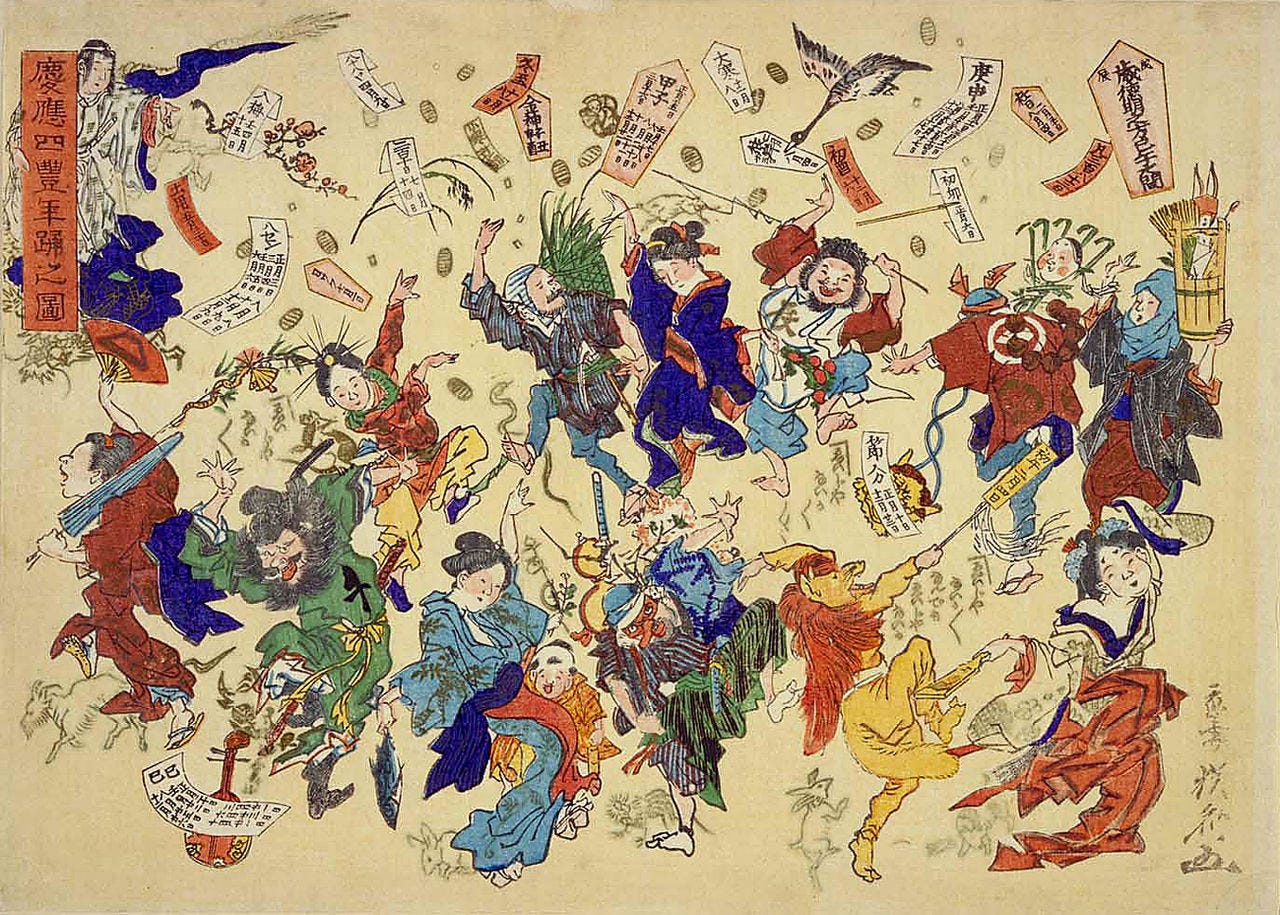Dancing manias were a recurrent phenomenon in a politically, socially and religiously chaotic Europe between the 14th and the 17th centuries. The phenomenon is also known as St. Vitus’ Dance, and involved outbreaks of masses of people compulsively dancing until they collapsed. Not rarely, the events followed upon some significant ordeal or calamity, such as a plague epidemic or violent conflict, and can be considered a sort of pseudo-ritualistic release of pent-up nervous energy, whose function, if we may speculate from evolutionary adaptation, may relate to the reformation of disadvantageous forms of social organization.
The fervor and spirit of revolution set free, liquidating rigid norms and institutions so that they can re-crystallize in more beneficial forms.
In other words, when shit hits the fan a bit too much, people tend to get a little batty and reject norms and customs, which incidentally also helps in reorganizing the tribe around the problems in question.
The Ee ja nai ka movement of the liminal space between the Tokugawa shogunate and the Meiji restoration in 19th century Japan is a case in point. In essence, this was a nation-wide carnivalesque eruption of dancing festivals and religious experimentation with a sprinkling of “free love” that went on for about a year before culiminating in mob violence. Among the triggers were a traumatic and rapid modernization intiated by Perry’s Black Ships and the US gunboat diplomacy as well as the 1868 civil war.
Something similar can be said about core aspects of the 60s counterculture against the background of Vietnam, the Cold War and the nuclear threat, and without even scratching the surface of this vast topic, we can recognize that the institutional and mediatic framing of relevant events and processes played a significant role in shaping and guiding the social forces let loose. This is of course not to invalidate the entire movement and paint it out as a tool for the establishment or something equally reductive. All of this was a complicated affair.
Nonetheless, it must be said that the phenomenon as such was “socially constructed” insofar as it was an expression of influential trends and social institutions. Adding to that, we know there were many attempts at co-optation, some of which arguably served to blunt the potential of the counterculture to effect significant societal reform. I.e. they made parts of it into a loyal opposition.
And my point here is to illustrate that the psychology behind the “dancing mania” manifests as a phenomenon of institutional and social coherence, and that it as such can be strategically exploited.
Orwell illustrated this very aptly in Nineteen Eighty-Four with the Party’s regulated tradition of the “Hate Week”, whose purpose was precisely to periodically harness and release the potentially disruptive energies amassed through recurrent terror, violent repression and war propaganda.
But the thing I believe is most difficult to grasp from the outside is the essentially non-rational character of the collective act as such. It’s easy to sit back in one’s chair, thinking that I would naturally be one of the Weiße Rose or a dissident at one of the Nuremberg rallies just because there’s no clear rational reason to participate in the acts of the crowd.
That is, unfortunately, a category error. Participation namely isn’t predicated upon reason. It’s rather like cheering on one’s hockey home team with a bunch of friends and neighbours, the ritual play-acting at participating in violent conflict where allegiance is emotional, libidinous and an almost tangibly physical relation of nearness.
Rooting for the team is emphatically not an act of rational deliberation. It’s not inherently inimical to reason, of course, and can very well be congruent with the intellect (just like how our emotions can be proper and “in accordance with right reason”) but we’re not operating on the level of critical thinking here.
Right now, political deliberation in what passes for the public sphere is almost entirely reduced to the level of spectator sports. Two years of fear, isolation and incessant mediatic promotion of crisis, coupled with what probably amounts to the most intense political and ideological disciplining ever, has resulted in quite a bit of pent-up stuff ready to be released in any direction.
And for an isolated population of avid consumers, the triggers and the guiding framework would almost certainly have to come from the media.
While the current dancing mania happens to be one of orchestrated russophobia, it could conceivably have been any one of a number of things seeded in the dominant narratives for the last few years. Climate change. Terrorism. The radical right. But now, the willful escalation of a long-brewing conflict happened to cause a violent military response that pivoted the propaganda machinery’s quite awesome power towards Russia.
(Political ad for the Swedish Green Party. “More sun. More wind. More peace. We stand with Ukraine.” Spot the composite ideological puzzle pieces through Barthesian analysis and win fine prizes.)
For many people, all of this must be a wonderful relief from the drudgery and fear of the covid narrative. Now the invisible killer of children and grandparents, the potential terror of every sneeze and scratchy throat, has been superseded by a comfortably distant military conflict broadcast to us in the framework of entertainment. The opportunities for vicarious, passive participation and virtue signalling are also much more obvious, since this time, the antagonist isn’t just an abstraction. We now have a more accessible and versatile morality play where we can channel our emotions into rage against the enemy image, or indulge in self-righteous identification with the current sacrificial victim.
Almost every humanitarian NGO is accordingly right now marketing itself mainly in relation to the plight of the Ukranians, which, while undoubtedly real, is dwarfed by the situation in e.g. Yemen or Afghanistan:
Acute malnutrition is spiking across Afghanistan, and 95 percent of households have been experiencing food insecurity. Afghan children are starving to death nearly every day, according to humanitarian organizations.
“Afghanistan’s humanitarian crisis is in essence an economic crisis,” said John Sifton, Asia advocacy director at Human Rights Watch. “Afghans see food in the market but lack the cash to buy it. Health workers are ready to save lives but have no salaries or supplies. Billions have been pledged for aid but remain unspent because banks can’t transfer or access funds.”
US government actions since the Taliban takeover in August 2021, including suspending recognition of Afghanistan’s Central Bank, have cut off the country’s economy from the world and severely curtailed the payment of vital assistance and salaries of millions of teachers, health workers, and other essential workers. These measures, which US officials said were taken to sever the Taliban’s access to foreign assets, are now directly impairing Afghans’ basic human rights to a livelihood, food, health care, and life itself, Human Rights Watch said (HRW.org).
Yeah, so where are the calls for sanctions against the US over this blatant genocide?
(I don’t advocate for sanctions. The current round against Russia will very likely kill millions, not least in Afghanistan).
But the thing is, the hockey fans pictured above are not arguing. They’re not engaged in rational discourse. And neither are the vast majority of those reflexively raging against Putin in social media, or the otherwise intelligent people lambasting you as a traitor for posing perfectly reasonable questions regarding the dominant narratives.
Those who post these little Ukranian flags on their social media avatars are rather pledging allegiance. They’re expressing an identity, a group affiliation, and a devotion to certain narratives, symbols and authorities. And they’re doing this under duress, in an extremely attractive diversion from two years of fear and violent interference in their normal, everyday lives.
And when you attempt to rationally argue against this sort of posturing, you’re also in a sense committing a category error. If you try to “refute” an Oilers fan by arguing that the team hasn’t given the requisite effort for the last couple of seasons, he’s probably going to think you’re an idiot. At the very best, you’re going to get a rationalization for his feelings of belonging and immediate relation of affiliation, which were never really the result of active critical deliberation.
What’s more, when you protest these sorts of allegiances, you will likely be perceived as an enemy.
To love someone or to commit to something is an act of the will - even a rational intention - but never the conclusion of a set of arguments. Loving a person is a free choice, an act of your immaterial essence, and can never be refuted on some recognition of objective fact through syllogism.
But getting people to realize that they have on some level actively made a choice, and that their allegiance is willful, is half the battle.








"These measures, which US officials said were taken to sever the Taliban’s access to foreign assets..."
The insanity & hypocrisy of this is staggering...
The Times of London reports that the US simply abandoned a truly astounding arsenal of military equipment and weapons. This reportedly includes up to 22,174 Humvee vehicles, nearly 1,000 armored vehicles, 64,363 machine guns, and 42,000 pick-up trucks and SUVs. So, too, the list of allegedly abandoned weaponry includes up to 358,530 assault rifles, 126,295 pistols, and nearly 200 artillery units. Oh, and the Taliban will likely inherit state-of-the-art military helicopters, warplanes, and other aircraft... The value of the abandoned equipment/weaponry estimates range from $10-$80 billion...
https://web.archive.org/web/20210901203254/https://www.themainewire.com/2021/09/heres-the-list-of-billions-in-military-equipment-the-us-left-behind-for-the-taliban/
I like your comparison with the hockey fans.
It seems to me that the choice of allegiance is made on a group level and then adopted by individuals. If your friends, family, neighbours - all your significant others - cheer for Oilers, it would be seen by them as a betrayal if you do not cheer or, worse, cheer for a team Oilers currently are competing with.
So dissenting is costly and painful. Moreover, as Hume once said: "If we believe, that fire warms, or water refreshes, it is only because it costs us too much pains to think otherwise." Thus we believe that Oilers are the best. Many do not even dare to consider the possibility that the current narrative might be wrong, because it might possibly lead you to pain and social isolation.